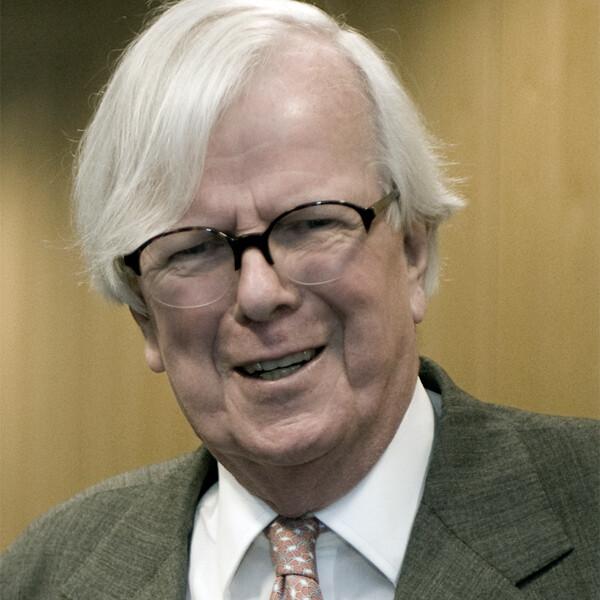Sir Roger Gibbs, 1934-2018
It was with great sadness that we learned that Sir Roger Gibbs has died. Sir Roger was the Chairman of Wellcome from 1989 to 1999, overseeing perhaps the biggest transformation in our history and laying the foundations for what Wellcome has become today.

In 2004, we named our new headquarters the Gibbs Building in his honour. Speaking at the building’s opening, Wellcome’s then Chairman, Sir Dominic Cadbury, told guests including Her Majesty the Queen: “The huge expansion of the research we fund and the creation of this building have been made possible by the growth in the Trust’s wealth under the leadership and skilful direction of my predecessor, Sir Roger Gibbs. It is entirely appropriate the building should be linked to his name.”
Sir Roger enjoyed a successful and distinguished career in the money markets of the City of London from the 1950s to the 1980s. He became a Trustee of the Wellcome Trust in 1983 and, together with Sir David Steel (former chairman of BP), oversaw the transition into an independent foundation that today spends £1 billion a year on improving health.
Part of the reason Sir Roger was interested in joining Wellcome was his own health. He had a major operation for cancer aged 40, and had become involved with many health-related charities. In 1982, aged 47, he ran the London Marathon and personally raised a record £440,000 for a CT scanner at Guy’s Hospital. He had other charitable commitments at the Royal National Pension Fund for Nurses, the London Clinic, the Tavistock Centre of Aphasia, and the Imperial Cancer Research Fund (a precursor of Cancer Research UK).
But he saw a niche for himself at Wellcome as someone who knew more about money and the City than medical research. At the time, Wellcome was governed by seven Trustees – five from a scientific background and two others. Within two months of becoming a lay Trustee, Sir Roger and Sir David – then the Chairman – were discussing radical change.
Securing the future
For almost 50 years, the Wellcome Trust had been the sole owner of the Wellcome Foundation, the pharmaceutical company left by Sir Henry Wellcome when he died in 1936. The Wellcome Trust was established by Sir Henry’s will in order to use profits from the company to support research into medical advances and the history of medicine.
But in 1986, Sir David, supported by Sir Roger, decided that the future of the Wellcome Trust would be more secure if it had income from sources other than the company. They floated the company on the London Stock Exchange and sold just over 25 per cent of the Trust’s shares in it, raising £200 million – almost ten times the Wellcome Trust’s existing reserves – and going on to earn more from the company in dividends than it had previously received.
In 1992, Sir Roger – now Chairman himself – decided that it was time to sell more shares in the company. In fact, he wanted the Wellcome Trust to give up its majority holding in the company and take its stake below 50 per cent. This was opposed by the company but allowed by the High Court, which ruled it was the Trustees’ duty to do what was in the best interests of the Trust.
A remarkable success
In July 1992, a second sale of shares raised an unprecedented £2.3 billion and took the Wellcome Trust’s stake in the company down to 40 per cent. This bold move – which the Financial Times called a “remarkable success” – allowed the Wellcome Trust to invest in other companies and markets, including the purchase of 56 acres of property in South Kensington, a deal negotiated personally by Sir Roger.
Then, in early 1995, Glaxo made an offer to Sir Roger to buy the Wellcome pharmaceutical company outright. It was a controversial move, one that would be opposed by Wellcome Plc, and Sir Roger and the other Trustees had a weekend to decide what to do.
In the end, Glaxo’s offer was too good to turn down, including not only cash, but also shares in Glaxo. Sir Roger was convinced he and his fellow Trustees had got the best deal for Wellcome, and it turned out to be a good decision.
Foresight and decision-making
When Sir Roger became Chairman of Wellcome in 1989, the charity was spending around £50 million a year on charitable activities. By the time he stood down in 1999, that figure had risen to £400 million a year, and was fuelling endeavours like the Human Genome Project, the Diamond Light Source synchrotron, growing international research funding and bold new programmes of public engagement with science.
Even then, however, it is doubtful he could have predicted where Wellcome would be today. Another 20 years on, Wellcome spends £1 billion a year thanks to the continuing stewardship of the investment portfolio that Sir Roger helped to establish and build up. People all over the world are benefiting from his foresight and decision-making as Chairman of Wellcome.
Of course, Sir Roger kept in touch with Wellcome. He paid a visit this summer and, despite his ill health, remained in typically good spirits. He was a loyal friend, down to earth, devoted to his wife and extended family, and always great fun.